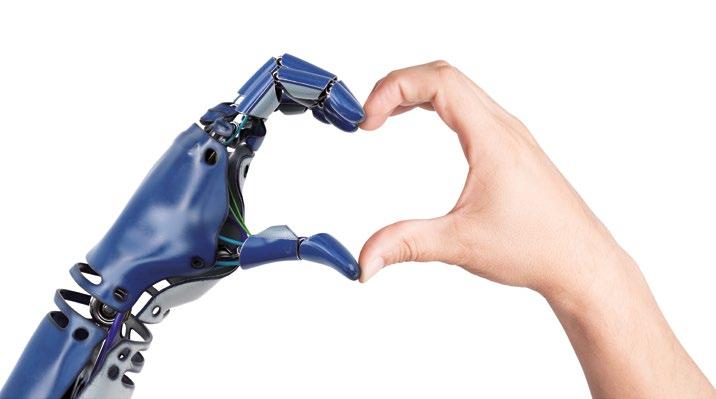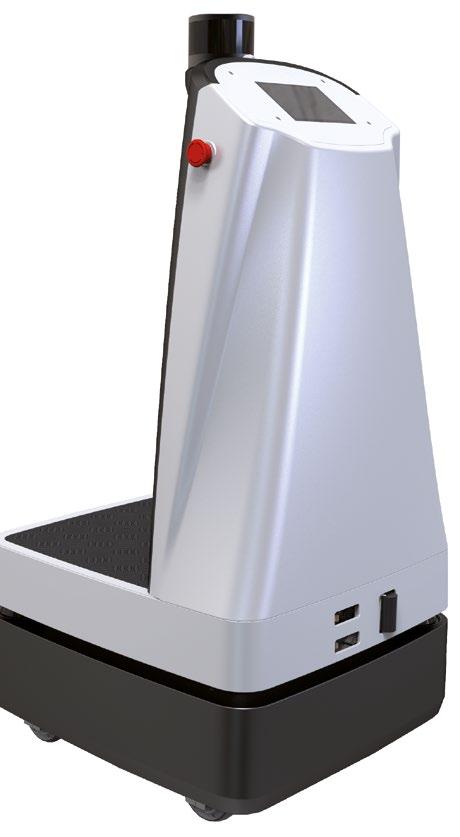
6 minute read
… knows that as an H-BRS graduate he can take many routes

New tasks for intelligent helpers
Research projects on autonomous robots completed successfully
Robots are stronger than humans, their movements faster and more precise. But before they can independently take on tasks similar to humans, many conceptual and technical challenges must be overcome.
With three research projects that attracted a great deal of attention at a conference, scientists at H-BRS have taken the performance and safety of autonomous systems a step further.
How can robots unburden hospital staff?
Relieving busy caregivers of logistical tasks, such as taking away dirty laundry or empty water bottles, is not just important during a pandemic. Thanks to the completed EU research project ROPOD, a market-ready robot will soon be available to take on this work. H-BRS developed the robot jointly with KU Leuven, Eindhoven University of Technology and the industrial partners SMF Ketels and Locomotec and tested it in the AGAPLESION Frankfurt Diakonie Clinics. The KELO 500 Dow can autonomously transport trolleys or hospital beds through the building. A map of the building in the robot’s memory system helps it to determine its own route, and it can even operate independently on several floors with the help of automated lifts. The main task of Sankt Augustin researchers was error analysis and what is called fleet management – the programmed routines enabling several robots to share the workload or stand in for each other in the event of a malfunction. In March 2020, the two industrial partners founded the joint venture KELO Robotics, which aims to bring the results of the project to series production. Logistics giant DHL is now interested in the KELO 500 Dow robot as well.
Colleague KELO 500 Dow independently pushes transport trolleys or beds through the clinic and communicates with the other electronic employees
Can robots assist in providing better care to relatives who require it?
In sparsely populated rural areas, where distances are greater and caregiving staff scarce, robots could help to cover the demand for care. The RoboLand research project has investigated whether this works in two Hessian districts. In cooperation with nursing scientists from Hochschule Fulda, the researchers from H-BRS tested the use of the telepresence robot “Double” in the households of people suffering from dementia. It consists of a mobile tablet at the top of a pole and can be controlled remotely by the relatives responsible for care. In addition to purely technical problems, the scientists also dealt with questions of acceptance. How do the people in need of care and the remote caregivers deal with this technology? Video observation provided important insights into the limitations of these proxy care systems. “It’s difficult to communicate with relatives when you’re looking into a room as if through a keyhole”, says Erwin Prassler, Professor of Autonomous Systems at H-BRS. For this reason, his follow-up project focuses on what is called immersive telepresence. The idea is to develop a robot with a 360-degree camera. The remote observer would wear data glasses that facilitate full spatial perception.
Is it possible to predict whether a robot will reliably and safely perform the task for which it is intended?
The VeriComp project, completed in November 2020, has an answer to this question. If, for instance, a robot’s task is to insert a screw into a wooden board, there are many factors to consider. How heavy is the board that one arm is holding? How much force does the other arm require to insert the screw? Are the two arms coordinated, and do they have the necessary number of joints for the intended movement? The entire process can be modelled and checked in the computer simulation. “This enables us to make reliable predictions with regard to both the successful execution of the task and questions of safety”, explains Nico Hochgeschwender, Professor of Robotics and Safety and Security of Autonomous Systems. The software developed at the university can be adapted to a wide variety of robot tasks and systems. This makes it interesting for robot developers and suppliers of individual components who want to offer tailored package solutions for customers.
How do robots learn from their own mistakes?
This is the question Alex Mitrevski, a doctoral student in the Department of Computer Science, is working on in cooperation with the Knowledge-Based Systems Group at RWTH Aachen. His approach is that an AI algorithm filters out “constraints”, i.e. necessary restrictions for solving a task, from a mass of data. Examples include the importance of not spilling when transporting water or that nails should be driven straight into a wall if possible. Simple, but not self-evident insights for a robot. Similar to a learning child, the machine is supported by human feedback. Mitrevski’s thoughts, presented at the renowned “International Conference on Intelligent Robots and Systems” (IROS), were recognised with the IROS Best Paper Award. “This is a very special occasion”, says Mitrevski’s supervisor Professor Paul G. Plöger. “Many researchers don’t achieve this in a 30-year academic career.”

Enjoy virtually with “Witality”
Researchers simulate digital wine tasting in every sense
On a terracotta terrace under the pines or in a small fish restaurant at the harbour, wine tastes very different than it does when sipping a small sample at the supermarket. Everyone can relate to this experience. But exactly what influence does ambience have on enjoyment? And can this atmosphere be created artificially? These questions are being addressed by the Witality research project. Over the next three years, the Institute of Visual Computing (IVC) at H-BRS will be working with the Institute for Viticulture at Hochschule Geisenheim University, DLG TestService GmbH and Pieroth Wein AG on a virtual environment for wine tasting.
“Our goal is to simulate a digital tasting situation that is as close as possible to the real experience”, says Ernst Kruijff, Professor of Human Computer Interaction at Hochschule Bonn-Rhein-Sieg. The wine and its taste remain real, of course, but the environment perceived by the eyes, ears and nose is artificial.
As realistic as possible
Various technical problems have to be solved. In a neutral lab, the slightly musty smell of a wine cellar is created by a cartridge with liquid scent that is atomised in the room. The background sounds come through headphones, and a pair of data glasses, known as a Head Mounted Display (HMD), provides the digitally simulated three-dimensional space.
Drinking with data glasses on works well already. The wine glasses commonly used for tastings just fit under the HMD. It will be more difficult to develop software that allows the tasters to fill out a questionnaire without destroying the digital illusion and its emotional perception. But the biggest challenge lies in the visual reproduction of the wine that the tasters are holding in their hands. This is because wine is always judged by viscosity and colour during tastings. This requires ray tracing, a physically correct calculation of light refraction. If the entire illusion is then coherent, Witality may not only be useful for research purposes in the lab, but also interesting for companies in the wine industry. From 2024, they could potentially use the software for market research or product presentations at trade fairs.
go
know your position, set your course, keep your stance
On the path to climate neutrality Interview with Katja Dörner, Mayor of Bonn, and University President Hartmut Ihne










